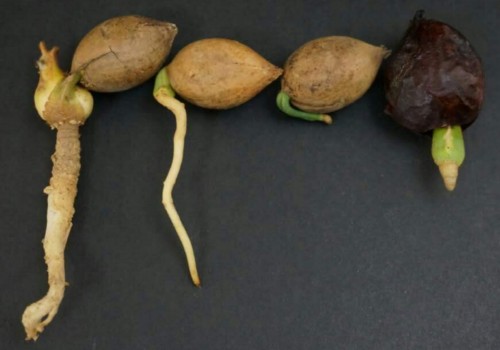How does the iron tree reproduce?
Iron tree, also known as cycad, is a kind of evergreen tree, although it can blossom, but it is rare to see, there is also a folk saying that iron tree blossoms rarely in a thousand years. It can be seen that the iron tree flowering is a very rare thing, of course, if it really blossoms, it also indicates auspiciousness and auspiciousness. Generally, we apply it to the landscape, but it also appears in the business place. And some bonsai friends can also make it into bonsai appreciation! So, how do iron trees reproduce?

Relatively speaking, iron tree is also relatively easy to reproduce seedlings, the most common method is tillering propagation, of course, sowing or cutting propagation can also be carried out. Generally speaking, iron trees raised in pots for 4-5 years tend to grow a lot of spherical "bumps" from their sturdy stems, and these "bumps" will also sprout and grow young plants. In that case, we can cut these young plants together with the "pimple" from the mother plant to breed the seedlings.
If there are new buds or seedlings on these "bumps", we will cultivate them with clean plain sand after cutting them off and smearing them with plant ash or sulfur powder and drying the wound. Generally, when planting, most of the "bumps" can be buried in the sand, and then sprayed with water to create a suitable humidity environment for its growth. Finally, put it in a semi-shady and ventilated place to slow down the seedlings. If it goes well, it usually takes about 2 months to take root.
However, if the leaves on the pimple are long and large, the original suggests cutting off the upper part of the leaf when planting, which can reduce water consumption and transpiration, which is more conducive to the rooting and survival of the pimple. If there is only a relatively immature leaf on the pimple, there is no need to cut it in half. Because the leaf is smaller, it does not consume much water, and it helps to carry out photosynthesis, making it easier for the ball to take root and survive.
Generally, after about 2 months, when the new root of the young plant grows to 5-6 cm long, we can choose the opportunity to dig it out from the plain sand culture environment, and then transplant it into the pot fertilizer, which is loose, breathable and permeable sandy pot soil as a pot plant. This time, there is no need for root trimming, leaf cutting treatment, directly on the pot planting and then irrigated. Also put it in the sun-ventilated place with sufficient scattered light for maintenance, and the normal management can be restored after the seedlings are slowed down smoothly.
But if the small "pimple" we cut from the mother plant of the iron tree does not have any roots, tender leaves or sprouts, it will usually be more difficult to reproduce and take a long time to breed. As the "pimple" originally had no root, we need to bury it in the yellow sand for Cui Gen. After the "pimple" grows new roots and sprouts, we transplant it into a fertile, loose, breathable and permeable sandy soil as a pot plant.
Time: 2019-06-04 Click:
- Prev

Attention should be paid to "two suitability and two essentials" in topdressing of edible fungi and identification of diseases of edible fungi.
Pay attention to "two suitability and two essentials" for topdressing of edible fungi
- Next

How to sow Iron Tree Seeds
As the saying goes: iron trees blossom, once in a thousand years. It can be seen that it is very difficult to let the iron tree blossom, but if we really encounter the iron tree blooming, it not only means that our planting method is very good, but also has an auspicious meaning. But
Related
- Fuxing push coffee new agricultural production and marketing class: lack of small-scale processing plants
- Jujube rice field leisure farm deep ploughing Yilan for five years to create a space for organic food and play
- Nongyu Farm-A trial of organic papaya for brave women with advanced technology
- Four points for attention in the prevention and control of diseases and insect pests of edible fungi
- How to add nutrient solution to Edible Fungi
- Is there any good way to control edible fungus mites?
- Open Inoculation Technology of Edible Fungi
- Is there any clever way to use fertilizer for edible fungus in winter?
- What agents are used to kill the pathogens of edible fungi in the mushroom shed?
- Rapid drying of Edible Fungi

